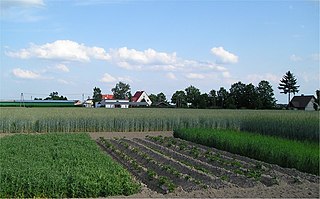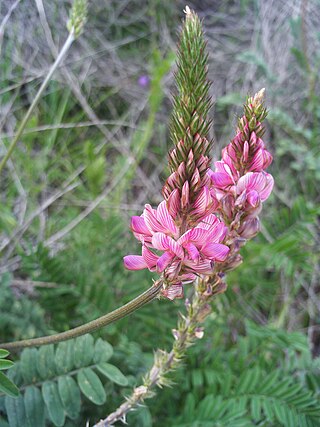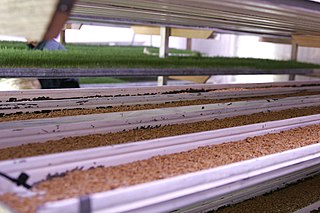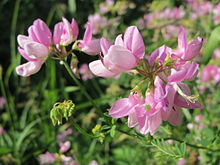
Crop rotation is the practice of growing a series of different types of crops in the same area across a sequence of growing seasons. This practice reduces the reliance of crops on one set of nutrients, pest and weed pressure, along with the probability of developing resistant pests and weeds.

The chickpea or chick pea is an annual legume of the family Fabaceae, subfamily Faboideae. Its different types are variously known as gram or Bengal gram, chhola, chhana, chana, or channa, garbanzo or garbanzo bean, or Egyptian pea. Chickpea seeds are high in protein. It is one of the earliest cultivated legumes, the oldest archaeological evidence of which was found in Syria.

Onobrychis viciifolia, also known as O. sativa or common sainfoin has been an important forage legume in temperate regions until the 1950s. During the Green Revolution it was replaced by high yielding alfalfa and clover species. Due to its anthelmintic properties, common sainfoin is a natural alternative to drugs to control nematode parasitism in the guts of small ruminants. This is the main reason why O. viciifolia returned to the scientific agenda in recent years.

Onobrychis, the sainfoins, are a genus of Eurasian perennial herbaceous plants of the legume family (Fabaceae). About 206 species are presently accepted. The Flora Europaea lists 23 species of Onobrychis; the main centre of diversity extends from Central Asia to Iran, with 56 species – 27 of which are endemic – in the latter country alone. O. viciifolia is naturalized throughout many countries in Europe and North America grasslands on calcareous soils.

Pasture is land used for grazing.

In agriculture, rotational grazing, as opposed to continuous grazing, describes many systems of pasturing, whereby livestock are moved to portions of the pasture, called paddocks, while the other portions rest. Each paddock must provide all the needs of the livestock, such as food, water and sometimes shade and shelter. The approach often produces lower outputs than more intensive animal farming operations, but requires lower inputs, and therefore sometimes produces higher net farm income per animal.

Ruminants are herbivorous grazing or browsing artiodactyls belonging to the suborder Ruminantia that are able to acquire nutrients from plant-based food by fermenting it in a specialized stomach prior to digestion, principally through microbial actions. The process, which takes place in the front part of the digestive system and therefore is called foregut fermentation, typically requires the fermented ingesta to be regurgitated and chewed again. The process of rechewing the cud to further break down plant matter and stimulate digestion is called rumination. The word "ruminant" comes from the Latin ruminare, which means "to chew over again".

Trifolium repens, the white clover, is a herbaceous perennial plant in the bean family Fabaceae. It is native to Europe, including the British Isles, and central Asia and is one of the most widely cultivated types of clover. It has been widely introduced worldwide as a forage crop, and is now also common in most grassy areas of North America, Australia and New Zealand. The species includes varieties often classed as small, intermediate and large, according to height, which reflects petiole length. The term 'white clover' is applied to the species in general, 'Dutch clover' is often applied to intermediate varieties, and 'ladino clover' is applied to large varieties.

Fodder, also called provender, is any agricultural foodstuff used specifically to feed domesticated livestock, such as cattle, rabbits, sheep, horses, chickens and pigs. "Fodder" refers particularly to food given to the animals, rather than that which they forage for themselves. Fodder includes hay, straw, silage, compressed and pelleted feeds, oils and mixed rations, and sprouted grains and legumes. Most animal feed is from plants, but some manufacturers add ingredients to processed feeds that are of animal origin.

Lotus corniculatus is a flowering plant in the pea family Fabaceae, native to grasslands in temperate Eurasia and North Africa. Common names include common bird's-foot trefoil, eggs and bacon, birdsfoot deervetch, and just bird's-foot trefoil, though the latter name is often also applied to other members of the genus.

Leucaena leucocephala is a small fast-growing mimosoid tree native to southern Mexico and northern Central America and is now naturalized throughout the tropics including parts of Asia.
Denitrobacterium is a genus of Actinomycetota with a single species, in the family Coriobacteriaceae. Originally isolated from the bovine rumen, Denitrobacterium are non-motile and non-spore forming. The only described species in this genus is Denitrobacterium detoxificans. The specific niche of this bacterium in the bovine rumen is theorized to be the detoxification/metabolism of nitrotoxins and miserotoxin.

The genus Securigera contains a number of plant species commonly referred to as crownvetch. It is a segregate of the genus Coronilla. The name Securigera was first published by A. P. de Candolle in 1805 with the single species Securigera coronilla, which is now considered to be a synonym of Securigera securidaca(L.) Degen & Dörfl. (1897), based on the earlier publication of the same taxon as Coronilla securidacaL. in 1753.

Cytisus proliferus, tagasaste or tree lucerne, is a small spreading evergreen tree that grows 3–4 m (10–13 ft) high. It is a well known fertilizer tree. It is a member of the Fabaceae (pea) family and is indigenous to the dry volcanic slopes of the Canary Islands, but it is now grown in Australia, New Zealand and many other parts of the world as a fodder crop.

Zygaena ephialtes is day-flying species of burnet moth found in Europe. It is typically found in xeric habitats, and populations have recently decreased. It also exhibits Müllerian mimicry with other species, like Amata phegea.

Lolium multiflorum is a ryegrass native to temperate Europe, though its precise native range is unknown.

Gliricidia sepium, often simply referred to as gliricidia or by its Spanish common name madre de cacao, is a medium size leguminous tree belonging to the family Fabaceae. It is an important multi-purpose legume tree, with a native range from Mexico to Colombia, but now widely introduced to other tropical zones.

Desmodium paniculatum, the panicled-leaf ticktrefoil, narrow-leaf tick-trefoil or panicled tickclover, is a perennial herb in the pea family, Fabaceae. Belonging to a nearly cosmopolitan genus, the panicled-leaf ticktrefoil is a common native to Eastern North America, ranging from Quebec to Florida and as far West as Texas, Nebraska, and Ontario. The sticky loment can be found in disturbed areas that receive plenty of light, such as roadsides, parks, and abandoned fields.
Brachiaria ruziziensis or Congo grass is a forage crop that is grown throughout the humid tropics. With fast growth at the beginning of the wet season due to strong seedling vigour, ease of establishment, good seed production and yield and the ability to suppress weeds it has the ability to become developed into the most important forage crop planted in the tropics. With the aid of genomic tools to research the genotype and gain more information there is the ability to increase breeding programs which are currently rather limited.

Coronilla scorpioides, the yellow crownvetch, is a species of annual herb in the family Fabaceae. They have a self-supporting growth form and compound, broad leaves. Individuals can grow to 20 cm tall.





















